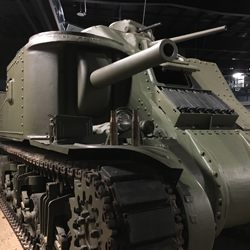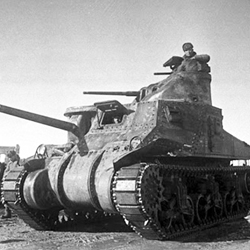The M3 Lee was an American medium tank used during World War II. In Britain, the tank was called by two names based on the turret configuration and crew size. Tanks employing US pattern turrets were called the “Lee”, named after Confederate general Robert E. Lee. Variants using British pattern turrets were known as “Grant,” named after Union general Ulysses S. Grant.
The first operational M3s were produced in late 1941. The U.S. Army needed a medium tank armed with a 75mm gun and, coupled with the United Kingdom’s immediate demand for 3,650 medium tanks,the Lee began production by late 1940. The design was a compromise meant to produce a tank as soon as possible. The M3 had considerable firepower and good armor, but had serious drawbacks in its general design and shape, including a high silhouette, an archaic sponson mounting of the main gun preventing the tank from taking a hull-down position, riveted construction, and poor off-road performance. Once the more nimble and effective M4 Sherman tank became available in larger numbers the M3 was quickly phased out. In spite of this, it was considered by Hans von Luck (an Oberst (Colonel) in the Wehrmacht Heer and the author of Panzer Commander) to be superior to the best German tank at the time of its introduction, the Panzer IV.
The M3 had a “fortress” like appearance to it with the high profile and multiple guns at every level. The design was unusual because the main weapon – a larger caliber, medium-velocity 75 mm gun – was in an offset sponson mounted in the hull with limited traverse. The sponson mount (projection extending from the side) was necessary because, at the time, American tank plants did not have the design experience necessary to make a gun turret capable of holding a 75 mm weapon. A small turret with a lighter, high-velocity 37 mm gun sat on top of the tall hull. A small cupola on top of the turret held a machine gun. The use of two main guns was seen on the French Char B1 and the Mark I version of the British Churchill tank. In each case, two weapons were mounted to give the tanks adequate capability in firing both anti-personnel high explosive and canister ammunition and armor-piercing ammunition for anti-tank combat. Using a hull mounted gun, the M3 design could be produced faster than a tank featuring a turreted gun.
The M3’s first action during the war was in 1942, during the North African Campaign. British Lees and Grants were in action against Rommel’s forces at the Battle of Gazala on 27 May that year. Their appearance was a surprise to the Germans, who were unprepared for the M3’s 75 mm gun. They soon discovered the M3 could engage them beyond the effective range of their 5 cm Pak 38 anti-tank gun, and the 5 cm KwK 39 of the Panzer III, their main medium tank. The M3 was also vastly superior to the Fiat M13/40 and M14/41 tanks employed by the Italian troops, whose 47 mm gun was effective only at point-blank range, while only the few Semoventi da 75/18 self-propelled guns were able to destroy it using HEAT rounds. In addition to the M3’s 75 mm gun outranging the Panzers, they were equipped with high explosive shells to take out infantry and other soft targets, which previous British tanks lacked.
Despite the M3’s advantages and surprise appearance during the North African battles, it could not withstand a hit from the German high-velocity 88 mm Flak gun. A shell from an 88 mm gun would go through most anything and the M3 did not have the armor to deflect such a blow. The high silhouette and low, hull-mounted 75 mm were tactical drawbacks since they prevented return fire from a hull-down position. In addition, the use of riveted hull superstructure armor on the early versions led to spalling, where the impact of enemy shells caused the rivets to break off and become projectiles inside the tank. Later models were built with all-welded armor to eliminate this problem. These lessons had already been applied to the design and production of the M4.
Beginning from 1941, 1,386 M3 medium tanks were shipped from the USA to the Soviet Union. Of these, 417 were lost during shipping to German submarines, naval and aerial attacks en route. These were supplied through the American Lend-Lease program between 1942 and 1943.
Like British Commonwealth units, Soviet Red Army personnel tended to refer to the M3 as the “Grant”, even though all of the M3s shipped to Russia were technically of the “Lee” variants. With almost 1,500 of their own T-34 tanks being built every month, Soviet use of the M3 medium tank declined soon after mid-1943. Soviet troops still fielded their Lee/Grant tanks on secondary and quieter/less-action fronts.
By the time the Pacific, China and Burma theaters started to ramp up the M3 became outdated. More modern models such as the M4 Sherman quickly took place of the M3.






